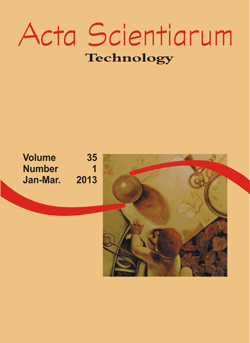<b>Photocatalytic Oxidation Process (UV/H<sub>2</sub>O<sub>2</sub>/ZnO) in the treatment and sterilization of dairy wastewater</b> - doi: 10.4025/actascitechnol.v35i1.11132
DOI:
https://doi.org/10.4025/actascitechnol.v35i1.11132Palavras-chave:
heterogeneous photocatalysis, chemical kinetics, wastewater treatmentResumo
Advanced Oxidation Processes (AOP) have attracted much interest of scientific and industrial communities. Therefore, this process was employed experimentally to determine its efficacy in treating dairy effluents. For this, it was employed an artificial light reactor using photolysis (UV), hydrogen peroxide (H2O2) as an oxidant, and zinc oxide (ZnO) as an alternative catalyst. The variables studied in the photocatalysis were: H2O2, ZnO, under different values of pH, both in relation to the interferences with the reaction rate and with the process efficiency. First order differential equations were applied in determining the degradation rate over the hydraulic retention time (HRT); the F-test and the signal: noise ratio comparison were used to test the significance of variables. The AOP using photolysis UV, H2O2 and ZnO was effective in COD removal with 80% efficiency. As for the sterilization, in terms of total and fecal coliforms the efficiency was 100%, with the most probable number of total and fecal coliforms (MPN 100 mL-1) equal to zero. A catalyst/oxidant/pH ratio was observed at 1 g  30 mL-1 4-1 for a better kinetic-chemical reaction, for 1 hour lighting.Â
Downloads
Downloads
Publicado
Como Citar
Edição
Seção
Licença
DECLARAÇíO DE ORIGINALIDADE E DIREITOS AUTORAIS
Declaro que o presente artigo é original, não tendo sido submetido í publicação em qualquer outro periódico nacional ou internacional, quer seja em parte ou em sua totalidade.
Os direitos autorais pertencem exclusivamente aos autores. Os direitos de licenciamento utilizados pelo periódico é a licença Creative Commons Attribution 4.0 (CC BY 4.0): são permitidos o compartilhamento (cópia e distribuição do material em qualqer meio ou formato) e adaptação (remix, transformação e criação de material a partir do conteúdo assim licenciado para quaisquer fins, inclusive comerciais.
Recomenda-se a leitura desse link para maiores informações sobre o tema: fornecimento de créditos e referências de forma correta, entre outros detalhes cruciais para uso adequado do material licenciado.















